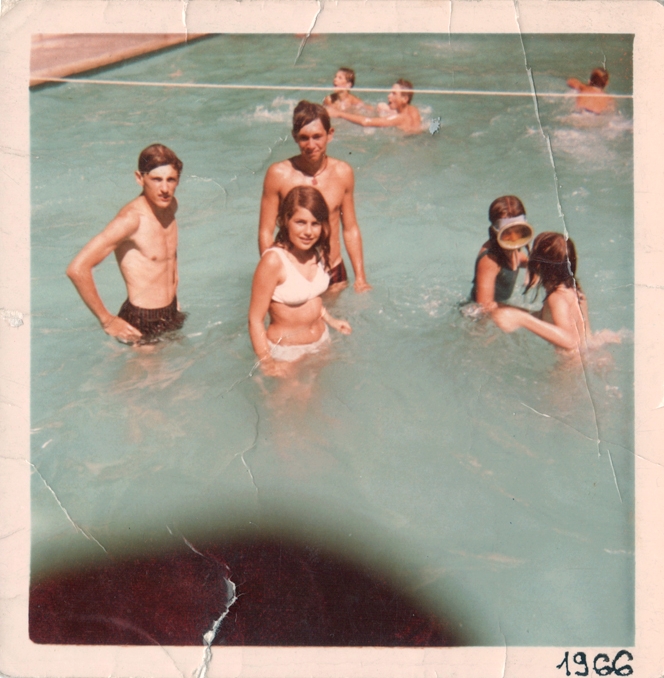Fiat takes the road, 1966
This is a guest post by my father, Aleksandar and his first trip abroad:
In 1966 I lived with my family in Beograd, then the capital of Yugoslavia. Two years earlier my father purchased our first car—a Fiat Zastava 600. Our minds immediately turned to road trips. We did a 2000 km test drive around four Yugoslavian republics in the summer of 1965. The car passed the test and we were ready for our first big trip abroad. The plan was that my father, mother, older sister and me, together with my aunt’s family would make a trip with two identical cars. We'd camp and store all our luggage on the roof rack since the car was hardly big enough to fit 4 people inside. If you look at the map below, this was a very, very ambitious trip for a car that has 600CCs and 23 horse power (really the strength of a modern-day motorcycle).
At the time, Yugoslavia was just starting to open up to the world, after their big break up with Russia. We had the ability to get passports, unlike the rest of the tightly-controlled eastern European countries. When traveling abroad we were allowed to apply for traveling money of $20US—in exchange for Yugoslavian dinars. Our currency back then was impossible to exchange, and $20 was only enough for a couple of days (the equivalent of $200 today). Finding the rest of the money was a huge achievement. We strapped our big tent, camping gear and personal belongings to the roof rack and started our trip in July of 1966.
The real challenge for our "mighty" machines came after few hundred kilometres when we reached the Slovenian and Austrian Alps. The roads were quite different in 1966—no highways. And since we were on a sightseeing trip we decided to avoid tunnels. If we reached 30km per hour, up and down the steep inclines, we were really speeding! In France, the roads had three lanes, the middle one being for passing cars in both directions. Germany, even back in 1966, was the only country with a fully developed network of highways without speed limits (still no limits today). We witnessed a few horrific car crashes along the way. I was 17 then, and you can imagine my fascination with a big western world, very different in many ways from the life that we were living. Attractive and bustling big cities like Salzburg, München, Basel and Paris had me in awe. I can clearly remember how we absorbed every sensation of sights like the white Hohensalzburg castle in Salzburg, Marienplatz in München, Sacre Coeur in Paris. I am positive that the impact of this first trip ignited the passion for travel that I still have. At any campsite we entered, we were the main attraction with our miniature cars, old fashioned tents and primitive camp equipment. Keep in mind that camp sites in Europe, even today, are quite different than in North America. Campers are much closer to each other and most of the sites are near the downtown core. A sense of community between travellers would develop after just few hours together. Our neighbours were extremely friendly and helpful in many ways. The friendships with people we met lasted for years after.
Our first visit to Paris was unforgettable, but where we stayed was even more extraordinary. We reached Paris quite late at night after hours of driving in a maze of streets. I will never forget "Strangers in the night" played on the radio as we cruised down Boulevard Phériphérique around and around the city. When we finally arrived at the one of two campsites in Paris, it was full. They were kind enough to call the other one, only to find out that that it was full too. What now? Well, Paris is Paris. And they of course have a solution for situations like this. A church in Ivry-sur-Seine, a suburb of Paris even closer to the centre opened its doors. After another hour, at 3am we finally arrived at our destination. We set up our tents in a manicured grassy yard around the church, under green, mature trees. The next morning, we woke up in the centre of a pleasant little city, with the smell of fresh bread coming from the nearby boulangerie. The metro station was just steps away and on top of everything our stay was free! They said: “This is not official camping so we can't charge you anything.” Being very tight on money, this was music to our ears. What better way to start a fantastic week in Paris?
Sadly, only these two photos below survived. The first is from the plateau overlooking the Eiffel Tower. This is the entire travelling party, excluding my sister who took the photo. I am 2nd from the left. The second one is from the pool at the camp site on the shore of Lac Léman, near Lausanne. I am 1st from the left. I kept a friendship with the girl in the white swimsuit, from Uden, a little town near Eindhoven in Holland, for many years afterwards. And afterall, that’s what the trips are for—making friendships, collecting experiences, admiring the achievements of our civilization and enjoying natural wonders.






